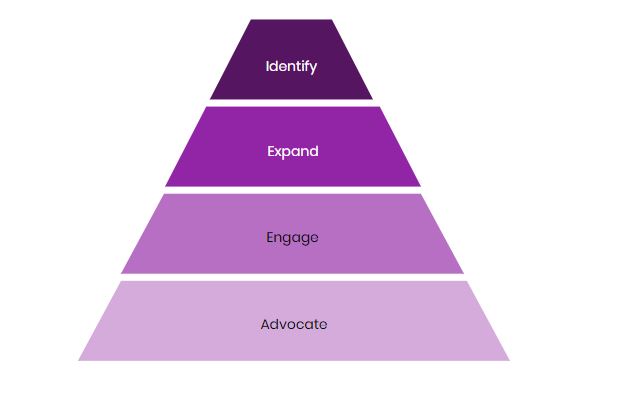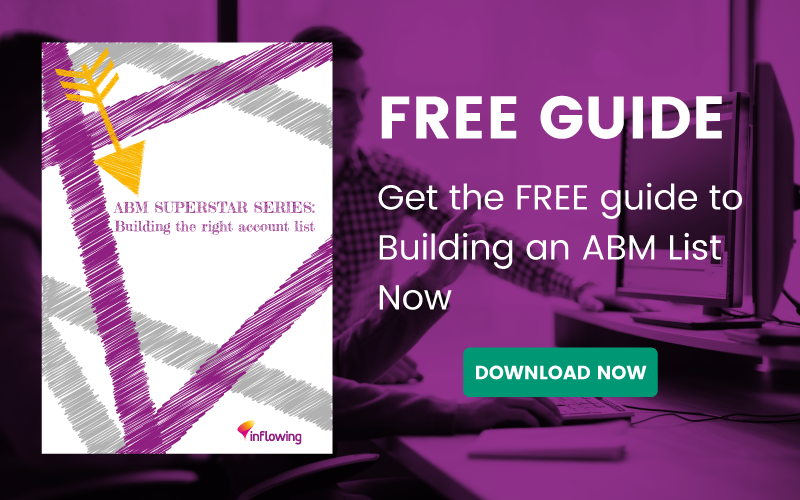You move people down the funnel using a variety of tactics – which I won’t go into here – but the overall point of this funnel is to cast a relatively wide net and then to narrow down this list until you have a small group who are ready to buy.
So, we’ve got that sorted. But what the heck is a flipped funnel?
With a “flipped funnel”, we’re talking strictly in relation to inbound marketing’s cousin account-based marketing (ABM). For a full run-down of ABM and its benefits, check out this post. For the purposes of this blog post, happening right now, live and in technicolour, we just need to know that ABM is about identifying a list of specific big-ticket target accounts, and designing a (usually) personalised and highly targeted campaign around closing one or two of them as customers, which – if you’ve done your job correctly – delivers a massive return.
The flipped funnel
Are you still with me? Great. So let’s apply the ABM ethos and strategy to this flipped funnel I keep hinting at.
First, let’s have a look at what a flipped funnel looks like. Spoiler alert – less like a funnel, more like a pyramid.

Identify
By putting the brains of sales and marketing together, you can develop a list of accounts you think are the best fit for your business. This might be because you’re already working in that particular industry, they’re just the right size, you have a good relationship with someone that works there – there could be a number of reasons why you think they’re worth spending time, budget and effort on. ABM platform Terminus coined the term “Ideal Customer Profile” (ICP) in which you name the various aspects that would make someone – well – an ideal customer. It might be useful for you to follow this process – but you may very well be able to think of 4 or 5 target accounts off the top of your head.
Expand
Now, using this methodology, you’ll usually begin with a specific contact that you’ll want to engage with to start the conversation. Well, that’s all very well and good, but let’s face it – there’s definitely more than one person in the decision-making process. Think about who else you might need to plug into within that organisation – a different department perhaps? Do you need to go higher up, or lower down the chain? Start to build your campaign around expanding your reach and getting in front of more people within that organisation. Account-based PR is a great way to do this, and it just so happens, we’ve already written a post about it – handy, eh? Bonus – this is also a very useful exercise in existing accounts, particularly if they are large enterprises. You may very well only be doing business with one very small corner of that business – you’ve got a foot in the door, can you edge your way in?
Engage
Now you know a) what accounts you want to target and b) contacts to target within that account, is time to start the meaty bit – engaging with them. This is where you’ll need your creativity cap and your marketing millinery (it’s a word – look it up). You need to think here about how and where you’re going to be able to get in front of these people with a message that really chimes. There are so many tactics at your disposal here – both online and offline – and it’s up to you to figure out and decide which are the best and which will be the most effective. The important thing to bear in mind here is that this all about being personalised and highly targeted – you want your marketing material to appeal directly to the contact and the account you’re addressing here. We’re not talking broad brush, broad appeal now – we’re talking very specific. A useful way to decide on what kind of tactics to use is often whether or not these contacts, or people from these businesses, have been on your website or not. You can use a variety of different tools to determine this (we like Albacross) but do bear in mind you’ll need to do some jumping through hoops GDPR-wise to use these. Once you know who’s coming on and who’s not, you can use a different blend of tactics for each group – personalised web pages and blog posts for those who are partying on your site, targeted ads, videos and social for those who aren’t. There are multitude of other things you can do, but that’s just a brief overview.
Advocate
Through diligently following the first three stages of this funnel, you have landed a customer – yay! Congratulations! But wait! Don’t go to the pub and order a bottle of prosecco just yet. There’s more work to be done here. And that’s turning your brand spanking new customer into an advocate. This is where we sort of, almost, crossover a bit into inbound marketing territory. The tail-end of the inbound methodology is about creating advocates, just as we’re trying to do here. Keep your new customer close to your marketing. Think about how you can keep them engaged, open and overall, a big fan of your business. Word-of-mouth, referrals and reviews – it’s powerful stuff, and you need to get it right to move on to your next big deal.
Flipping the funnel
It’ll depend on a number of factors as to whether this model is a good fit for your business or not. I’ll leave you with this – our blog post on whether inbound or ABM is the better fit for your business. If you think you’d like to explore an ABM or flipped funnel strategy and need a bit of guidance, get in touch.

